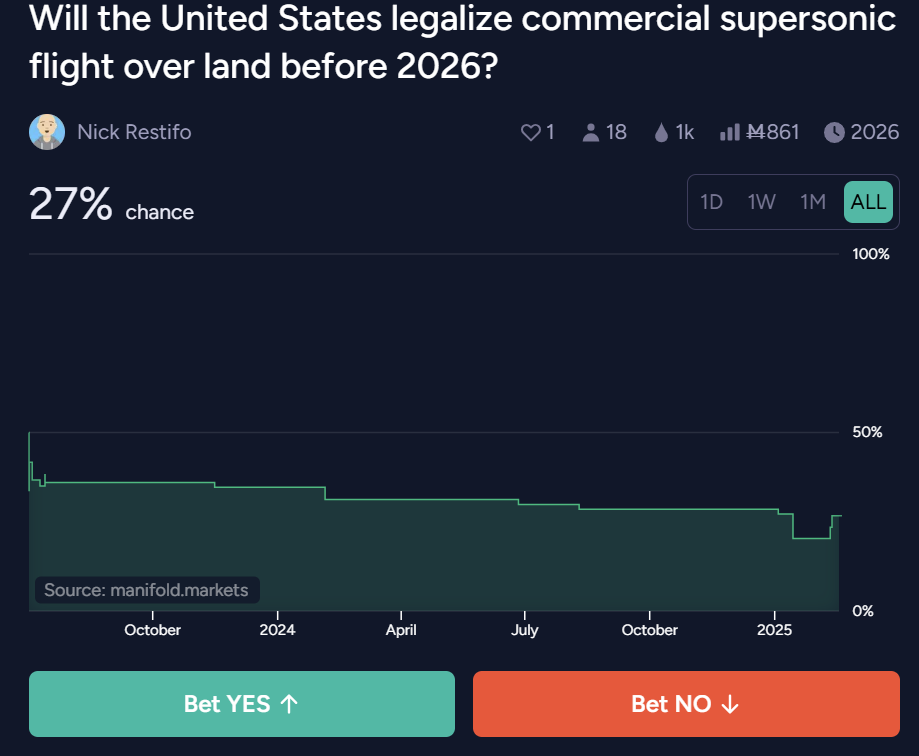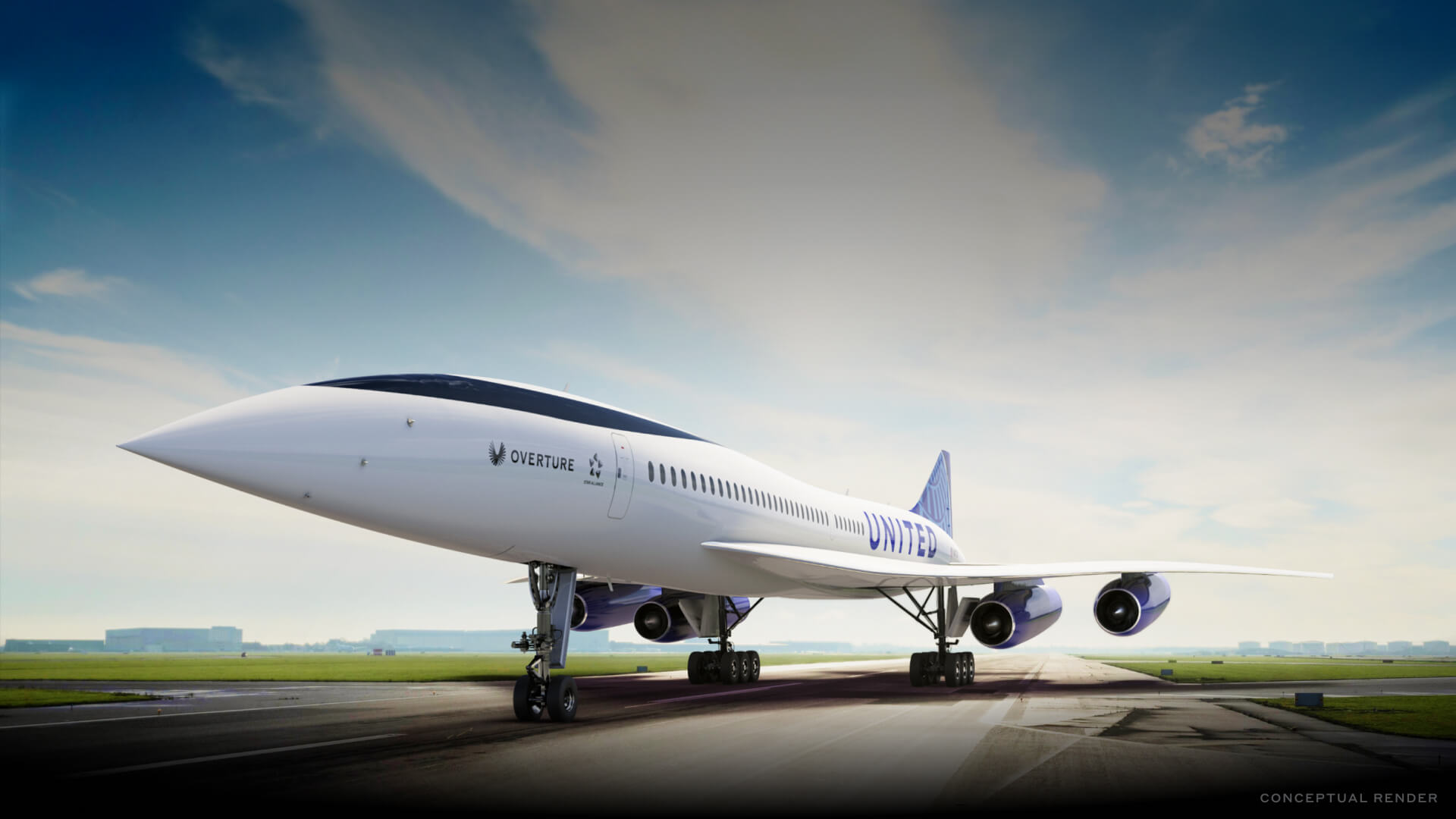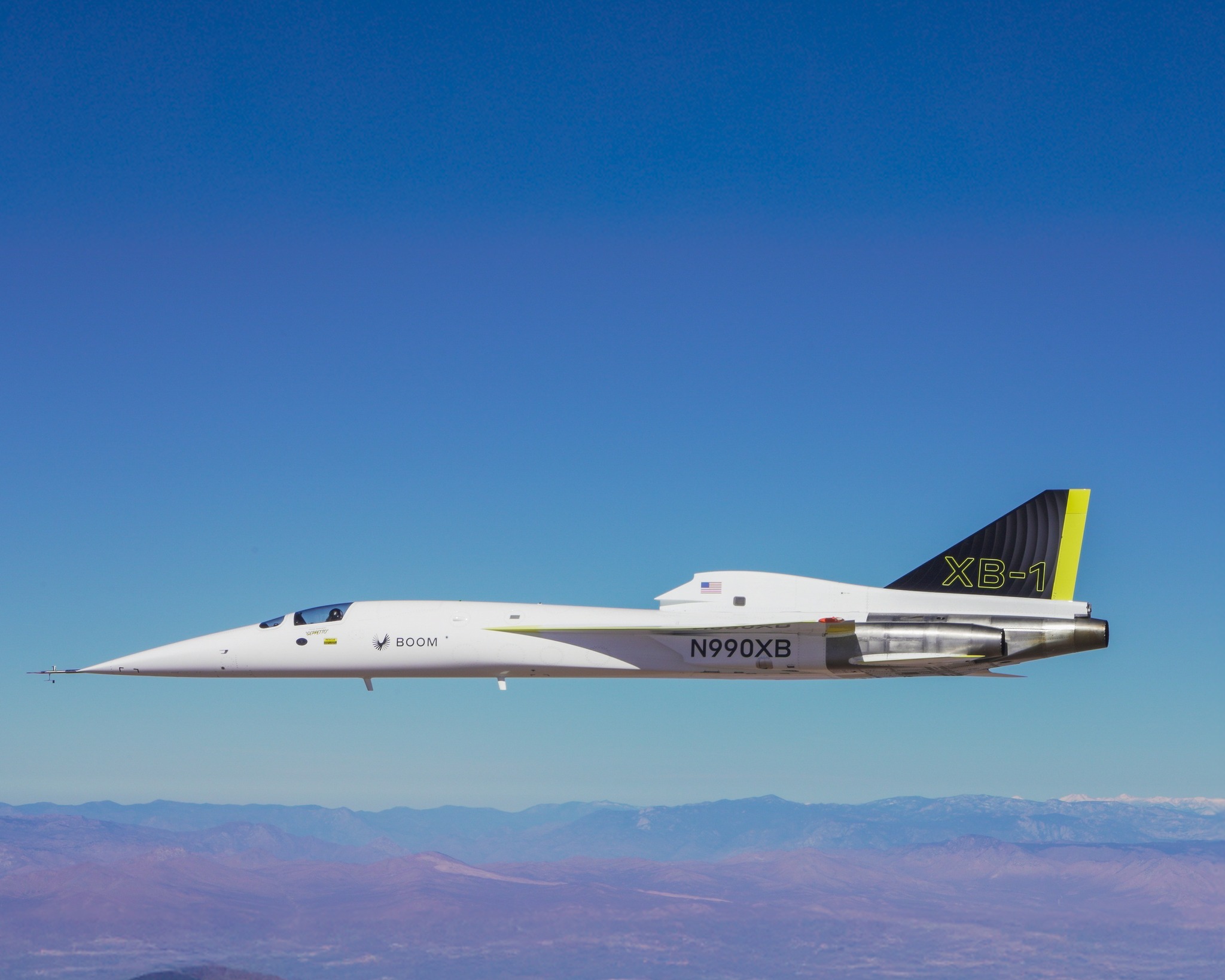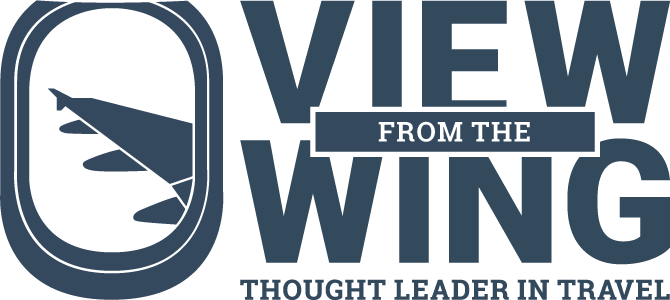There’s finally movement to bring back supersonic passenger planes, which have been off the table since Concorde which was never a commercial success. Boeing never produced its government-funded SST jet. The Soviet Tupolov Tu-144 nicknamed Konkordski crashed at the Paris Air Show in 1973. Supposedly the plane was built based on stolen plans from the French and Americans but they had been fed fake plans.
Boom Supersonic recently raised $100 million in a ‘down round’ to fund engine development though an engine is likely to cost much more than this.
Two weeks ago, Boom’s XB-1 test plane broke the sound barrier. The plane is about 30% of the size of their planned passenger jet. This is a long way off from having a passenger plane with engines certified and legally allowed to fly in a manner that’s useful to commercial airlines.
Ultimately, though, there’s no technical reason that supersonic passenger flight can’t happen. And it should be far quieter and more fuel efficient than Concorde, whose first flight was in March 1969.
Trump Administration May Legalize Supersonic Flight
Late in the last Trump administration, the FAA proposed loosening rules on supersonic flight which make operating sonic boom aircraft illegal. Elon Musk says this will finally happen.
This administration will get rid of all regulations that make no sense, like this one
— Elon Musk (@elonmusk) February 10, 2025
Prediction markets give legalizing supersonic a 27% chance of happening this year.

Meanwhile, Boom Supersonic says they can achieve supersonic speed without the sonic boom reaching earth.
Boom! We cracked it! Today we are introducing Boomless Cruise—supersonic flights up to 50% faster with no audible sonic boom.
We quietly (har har) demo'd this on XB-1's first supersonic flight—three times actually. pic.twitter.com/oe0VHJqNit
— Blake Scholl (@bscholl) February 10, 2025
Will Boom Supersonic Have An Engine?
Engines can cost billions of dollars to design and tens of millions of dollars apiece to purchase. It’s a huge bet for an engine manufacture, which $100 million doesn’t fund. They will need to sell large numbers of engines just to break even. If a manufacturer can’t sell several hundred engines they won’t recoup their development cost, after recouping production costs, let alone turn the project profitable.
Boom’s need to self-fund is as much about skepticism of the market as skepticism of the plane, or put another way, to the extent that it’s about the plane it’s not whether the plane is possible, or an engineering marvel, but whether the plane will be good enough, to be so compelling, that airlines cannot turn down placing orders and taking actual delivery in large numbers.
Most people in aviation think that the plane will never be built because it has a very limited market, relatively short flying range (for an initial plane, at least) and an expected need to fly overwater due to noise – likely still true even with quieter technology and regulatory changes. And so there’s limited willingness to invest.
Will Airlines Buy A Supersonic Plane?
Paul Graham, who invested in Boom’s latest $100 million raise, argues that the economics of the new plane will work because of densification of the passenger cabin while maintaining current pricing.
If business class travelers have a choice of a 10 hour subsonic flight from Seattle to Tokyo or a 5 hour supersonic one at the same price, they're all going to take the 5 hour one. Which means all the business class travelers switch to supersonic.
— Paul Graham (@paulg) January 29, 2025
And, he says, this means that all airlines flying long haul premium cabins will be forced to become buyers.

Credit: Boom Supersonic
In 2021, United Airlines placed an order for Boom Aerospace’s promised Supersonic jets.

Credit: Boom Supersonic
Then in 2022 American Airlines followed suit. Japan Airlines is an investor in the company. However these aren’t exactly ‘firm’ orders.
What most people don't realize about Boom is that if they ship an airliner at all, every airline that flies internationally will have to buy it or be converted against their will into a discount airline, flying tourists subsonically.
— Paul Graham (@paulg) January 29, 2025
On the other hand,
- No U.S. airline ever purchased a Concorde, though orders were placed by Pan Am, Continental, TWA, American Airlines, Eastern, United and Braniff.
- There were also orders from Qantas, Air India, Sabena, Air Canada, Lufthansa, and even Middle East Airlines and others which never came to fruition.
- Only British Airways and Air France took actual deliveries of new aircraft.
- The only other committed order came from Iran Air, and that was cancelled after the Iranian revolution.
Oddly Braniff did briefly own Concordes for a few hours at a time. They operated service between Dallas and Washington Dulles in conjunction with Air France and British Airways, but to do so they were required to take ownership of the plane for the flight segment in order to operate under their own certificate of airworthiness.
As well as changing flight crews the US approved documentation and procedures had to be present on the flight deck, which meant that the UK/French documentation had to be stored in the forward toilet.
There also had to be a change in the aircraft registration, while being flow on the Dallas – Washington – Dallas routes the “G” or “F” was covered up with white tape. On landing at Washington the ground staff would pull work ladders up to the tail and peel of the F- or G- registration numbers and changed them to an “N” with two letters and the numbers “94″ after that. This was repeated every time the Concordes landed in the US from Europe.
But This Could Still Succeed!
If operating economics are good enough, supersonic is a huge marketing advantage. The market between East Coast and London and Paris and maybe Frankfurt and Zurich may be robust enough to support customers paying a sufficient premium for supersonic, and competition for these customers is fierce. Once an airline takes the plunge, others may as well.

Of course short east coast transatlantics don’t offer as much of a time advantage as East Coast – Asia or Europe – Asia but those involve greater travel over land and greater regulatory skepticism. Existing airlines, even that have placed orders for these planes, may lobby against it preferring a status quo to one where they have to make huge capital investments that will be matched by other carriers.
Then again, 3-4 hours flights to London and Paris allow for morning departures that land in time for dinner, and after work departures from Europe that allow passengers to make it home for dinner as well.
The best-positioned carriers in the world to execute on this would be British Airways and American Airlines, with their diverse slot portfolio at London Heathrow – and the ability to finally make good on American’s slots at New York JFK. The shorter flight times would play havoc with slot usage, a modern day Boeing Boeing.
In that French play-turned-1965 film starring Tony Curtis and Jerry Lewis, a cad who liked flight attendants so much he was dating three of them (for Air France, Lufthansa, and British United Airways) and their international routes never had them in town at the same time.
All of the cabin crew live with him whenever they’re in Paris, with photos and personal touches swapped out to match each one’s arrival. But then the jet age meant faster planes, screwing up their schedules, and bringing them back to him all at the same time. Hijinks ensue. And so would it happen with slots.
Delta, with its 49% stake in Virgin Atlantic, could probably manage this as well but their slots aren’t nearly as diverse as BA’s. (Indeed, Virgin can’t really operate connecting banks with their slots today.)
There are always airlines that have come along and said ‘the transatlantic market is so robust, we only need to capture 1% of it to profit’ but never offer a compelling reason why they would capture that 1%. In fact, without the sales teams and corporate contracts, frequent flyer programs and robust frequencies they never do. Airlines like Eos and Maxjet never made it.
But supersonic would be a difference-maker, at least until other carriers pulled the trigger, too. And they wouldn’t just share shift business travelers on premium fares (though often at lower, more deeply discounted fares than you’d expect) but they would shift frequent flyer program preference and therefore credit card co-brand revenue as well.
Also think that many business travelers would switch loyalty programs over it, which is a threat out of proportion to the number of transoceanic flights. It might be the only product innovation in decades that has threatened that.
— Patrick McKenzie (@patio11) January 29, 2025
If regulations are changed to allow for supersonic flight over land while controlling for noise, then there will be technological development and we’ll eventually see commercial flight at faster speeds. It’s unclear whether Boom Supersonic in particular gets there. But ultimately the technology is possible – and needs to advance enough so that the economics supports it.


This will never fly as there is no engine. GE, Pratt, and Rolls all looked at it and declined. There is nobody else. Remember, even COMAC did not develop their own engine.
As for the “orders”. They have no cancellation penalty. I personally ordered 100 Boom planes on the same terms as AA and United.
Legalizing it and building it is one thing. Making it economic for average people is something else. It won’t happen soon.
Developing the engine absolutely is the most difficult part of this, but it is doable. GE, Pratt, and Rolls all said no because they don’t see the market for the engines as sufficiently large to justify the R&D and tooling investment, not because it’s an insoluble problem. (I mean, Intel didn’t want to build ARM-based chips for the iPhone because Paul Otellini didn’t think the market was there …)
That doesn’t mean Boom will succeed, of course, and it’s always safer, easier to bet on failure. I think it will be incredibly difficult, but engine technology, materials technology, computer based design and engineering all are much more advanced than they were 50 years ago. At the same time, the international business traveller market is vastly bigger, too. And if Boom has solved the noise issue, that eliminates one significant reason the Concorde was not a commercial success.
We all should be rooting for Boom.
The other great equalizer that Gary missed will be the value granted to non-mega airports. The relatively smaller Boom planes should be able to take advantage of shorter runways, since they won’t carry nearly as many passengers like widebodies. That means, rather than using LHR, airlines could launch translatlantic from LTN, STN, or LCY.
That would crack many a nut in the US as well. Imagine flying supersonic from DAL or MDW.
Color me skeptical. If someone is in that big of a hurry, videoconferencing is going to be even faster.
A quarter of the way through the 21st Century, about the only meetings that actually require face-to-face contact are ones that aren’t supposed to leave an audit trail behind them.
I’m very skeptical because video conferencing is so much cheaper and less time consuming. The fares are going to be very high and I’m not certain the market and justification are there. I’d love to see if succeed, but I’m not putting money on it.
If supersonic flights are permitted over land and longer US domestic flights can be reduced to a couple of hours or less, think of all the drink and meal services that will be eliminated. Probably a reduction in FAs as well. This alone could be a huge selling point to our premium domestic fleet. LOL.
I’m sure the sledgehammer approach to regulations will be great for air travel safety
If we build a rocket ship that can land itself, we can build a supersonic plane again. Sad people are so pessimistic about this.
The issue is that supersonic airplanes do not seem economical to airlines and since jet travel was introduced in 1958 airlines have been very content with the same speeds. What airlines want are fuel efficient planes that they can jam as many seats as possible into.
To all the naysayers in the comments, as the geniuses never said, “think small!”. 😉
@L3 — Yup. No engine. End of story.
Gary, this isn’t about ‘red tape,’ or regulations—besides, in the US, we have one-party rule for at least two years (until the midterms in 2026, unless there is some ‘irregularity’), and that party is de-regulating and privatizing everything.
So, in that case, it’s about ‘funding,’ namely for design, production of these new engines, which as you correctly pointed out, $100 million is likely not enough. Perhaps, Elon will get involved, take a few spare billion from the federal government’s coffers saved by not feeding starving children in Africa to fund this R&D so that the 0.1% can get to and from London a little faster. So worth it… /s.
Also, while Boom claims it broke the sound barrier without any sonic boom, I suspect that’s more ‘hype’ than reality. Then again, prove me wrong, fellas.
This all feels like a venture capital pump-n-dump scheme for investors and for airlines to market that they’re going supersonic ‘again!’ without any substance to their claims. Are we really that gullible?
@Common Sense — Obvious ‘troll’ but why not use any of your typical monikers on here, like @Michael Mainello, @Mike P, @Andy S, or @Mantis—so who is this really? Like, have some pride for your ‘work’ for goodness sake.
And I know ‘Daddy’ keeps using that phrase but just saying that your opinion is ‘common sense’ does not make it so. In fact, there is nothing ‘common’ about supersonic air travel at all. It’s truly a technological marvel. If Boom pulls this off, which I highly doubt, then that will be miraculous as well.
The only “Boom” from Boom Aerospace will be from when they enter Chapter 7.
But I congratulate them for breaking the sound barrier, a feat that was first done in 1947. And to do with J85 engines first used in the 1950’s is quite a feat.
If I were them, I’d start a Go Fund Me for $30,000,000,000 – it would be a start to getting a real airplane with real engines built.
I am one of those optimistic that supersonic travel will return for passengers willing to spend a lot of money. I think that the big markets will be transpacific and through the Middle East.
The Concorde development started in earnest in 1962 with a signed agreement between the British and French governments. Some of the technology was from prior to that date and some was after that date. That dates the technology to about 60 years old with only some newer than that. Boom will definitely be using updated technology to build a marketable airplane.
@jns — Even if this ‘company’ gets a few billion dollars from an oligarch to actually build the engines, it’s not so much the technological hurdle as the economic viability—it will still be low demand, high cost to operate, as was the Concorde. So, as Steven Tyler said: ‘Dream On’
“Dream on, dream until your dreams come true”
@jns — See you onboard!
They do have a point about the F/J seats vs. supersonic speeds. I don’t need a flat bed from New York to Europe anymore because it is half the time. Even New York to Tokyo in a domestic first class seat becomes actually manageable, and people WILL pay for that. The math ties.
Perhaps consider now that Europeans don’t want Americans here any faster than they need to be. US government officials in particular (or pseudo ones) are about as welcome as the bubonic plague or maybe Joseph Goebbels.
Maybe it’s best to work on better video conference technology so folks can look their best while they stay at home in the US!